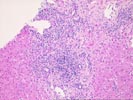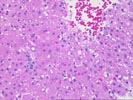Comment:
Overall the histologic changes, together with the clinical
history, indicate a chronic hepatitis with a prominent lobular
inflammatory component. The etiologic considerations include the
hepatitis viruses (which appear to be have been excluded
serologically), autoimmune hepatitis, and drug induced injury.
The histologic features do not strongly point to any of the
possibilities, and an etiologic diagnosis must depend on
ancillary clinical and laboratory information.
Previous Biopsies on this Patient:
None
TPIS Related Resources:
Liver Transplant Topics


The liver biopsy shows an intact hepatic architecture with portal inflammation but no significant fibrosis. There is a variable mononuclear infiltrate within the portal tracts. In one portal tract this is associated with mild bile duct injury. Mild piecemeal necrosis (interface hepatitis) is also seen. The infiltrate is primarily small lymphocytes together with scattered plasma cells. Mild ductular proliferation with occasional eosinophils and neutrophils are also seen. The lobules demonstrated glycogenated nuclei and mild microvesicular steatosis. Of particular note, however, is the presence of a moderate inflammatory infiltrate composed of mononuclear cells with scattered eosinophils and neutrophils. In addition, there are pigment laden macrophages within the lobules. These inflammatory changes tend to be accentuated around the central vein and are accompanied by focal necrosis and occasional acidophilic bodies.
Overall, the changes support a diagnosis of mild chronic hepatitis, although no strong etiologic clues are presented by the biopsy. The histologic activity index is assessed as follows:
| KNODELL'S HISTOLOGY ACTIVITY INDEX | ||
|---|---|---|
| Feature | RANGE | SCORE |
| Periportal and bridging necrosis | (0-10) | 1 |
| Intralobular degeneration and necrosis | (0-4) | 4 |
| Portal inflammation | (0-4) | 3 |
| Fibrosis | (0-4) | 0 |
| TOTAL | (0-22) | 8/22 |
The numerical scoring system of histologic activity index (HAI) has been developed to grade the liver biopsies of chronic active hepatitis. This is based on four categories of periportal and bridging necrosis, intralobular degeneration and necrosis, portal inflammation and fibrosis, with total score of up to 22. This scoring system is correlated well with the severity of disease. A copy of the original paper published by the American Association for the Study of Liver Disease [Hepatology 1:431, 1981] is available at the Department of Pathology upon request.